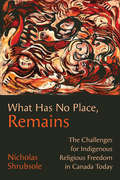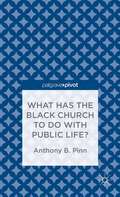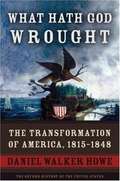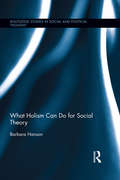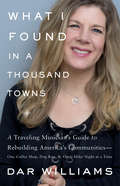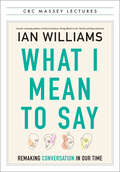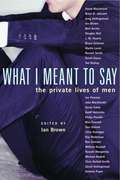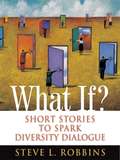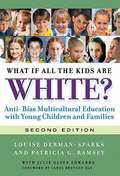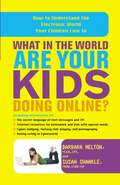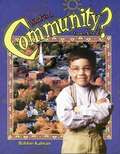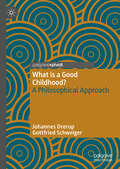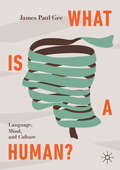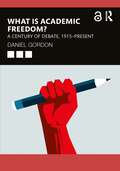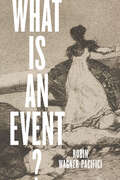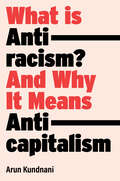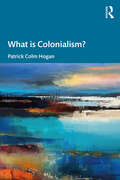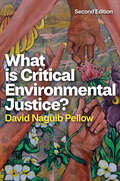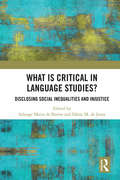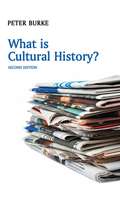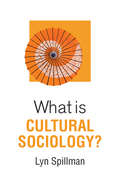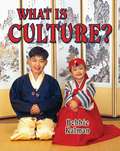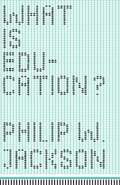- Table View
- List View
What Has No Place, Remains: The Challenges for Indigenous Religious Freedom in Canada Today
by Nicholas ShrubsoleThe desire to erase the religions of Indigenous Peoples is an ideological fixture of the colonial project that marked the first century of Canada’s nationhood. While the ban on certain Indigenous religious practices was lifted after the Second World War, it was not until 1982 that Canada recognized Aboriginal rights, constitutionally protecting the diverse cultures of Indigenous Peoples. As former prime minister Stephen Harper stated in Canada’s apology for Indian residential schools, the desire to destroy Indigenous cultures, including religions, has no place in Canada today. And yet Indigenous religions continue to remain under threat. Framed through a postcolonial lens, What Has No Place, Remains analyses state actions, responses, and decisions on matters of Indigenous religious freedom. The book is particularly concerned with legal cases, such as Ktunaxa Nation v. British Columbia (2017), but also draws on political negotiations, such as those at Voisey’s Bay, and standoffs, such as the one at Gustafsen Lake, to generate a more comprehensive picture of the challenges for Indigenous religious freedom beyond Canada’s courts. With particular attention to cosmologically significant space, this book provides the first comprehensive assessment of the conceptual, cultural, political, social, and legal reasons why religious freedom for Indigenous Peoples is currently an impossibility in Canada.
What Has the Black Church to Do with Public Life?
by Anthony B. PinnThis book argues against the common assumption that religious organizations, like black churches, should be involved in the public arena.
What Hath God Wrought: The Transformation of America, 1815-1848
by Daniel Walker HoweThe Oxford History of the United States is by far the most respected multi-volume history of our nation. The series includes two Pulitzer Prize winners, two New York Times bestsellers, and winners of the Bancroft and Parkman Prizes. Now, in What Hath God Wrought, historian Daniel Walker Howe illuminates the period from the battle of New Orleans to the end of the Mexican-American War, an era when the United States expanded to the Pacific and won control over the richest part of the North American continent. Howe's panoramic narrative portrays revolutionary improvements in transportation and communications that accelerated the extension of the American empire. Railroads, canals, newspapers, and the telegraph dramatically lowered travel times and spurred the spread of information. These innovations prompted the emergence of mass political parties and stimulated America's economic development from an overwhelmingly rural country to a diversified economy in which commerce and industry took their place alongside agriculture. In his story, the author weaves together political and military events with social, economic, and cultural history. He examines the rise of Andrew Jackson and his Democratic party, but contends that John Quincy Adams and other Whigs--advocates of public education and economic integration, defenders of the rights of Indians, women, and African-Americans--were the true prophets of America's future. He reveals the power of religion to shape many aspects of American life during this period, including slavery and antislavery, women's rights and other reform movements, politics, education, and literature. Howe's story of American expansion culminates in the bitterly controversial but brilliantly executed war waged against Mexico to gain California and Texas for the United States. By 1848 America had been transformed. What Hath God Wrought provides a monumental narrative of this formative period in United States history.<P><P> Pulitzer Prize Winner
What Holism Can Do for Social Theory (Routledge Studies in Social and Political Thought #91)
by Barbara HansonThis book reconsiders the nature of positivist philosophy in social science theory based on classical and medieval thought in what later became "Europe." It argues that social theory is being held back by antagonistic debates over science, positivism, objectivity, and universal law - debates which appear unnecessary, narrow, and acontextual when their origins are examined. Positing that solutions to these impasses can be found by moving to alternative holistic epistemology, and looking at issues in terms of interrelations rather than parts, the book shows the promise of a social theory that provides a unit of analysis that mediates between local and global relations.
What I Found in a Thousand Towns: A Traveling Musicians Guide to Rebuilding Americas CommunitiesOne Coffee Shop, Dog Run, and Open-Mike Night at a Time
by Dar WilliamsA beloved folk singer presents an impassioned account of the fall and rise of the small American towns she cherishesDubbed by the New Yorker as "one of America's very best singer-songwriters," Dar Williams has made her career not in stadiums, but touring America's small towns. She has played their venues, composed in their coffee shops, and drunk in their bars. She has seen these communities struggle, but also seen them thrive in the face of postindustrial identity crises.Here, Williams muses on why some towns flourish while others fail, examining elements from the significance of history and nature to the uniting power of public spaces and food. Drawing on her own travels and the work of urban theorists, Williams offers real solutions to rebuild declining communities.What I Found in a Thousand Towns is more than a love letter to America's small towns, it's a deeply personal and hopeful message about the potential of America's lively and resilient communities.
What I Mean to Say: Remaking Conversation in Our Time (The CBC Massey Lectures)
by Ian WilliamsEnough small talk. Let’s get right to it: Why can’t we talk to each other anymore? What makes good communication? And how do we restore the lost art of conversation? In contemporary society, much of our communication exists in a new dimension, the online space, and it’s changing how we regard each other and how we converse. In the digital realm, we can be anonymous, we can make false and hurtful comments yet evade consequences in a hurried scroll of clicks and swipes. But a good conversation takes time and patience, courage, even. We need to realize that one-half of our conversations is, in fact, listening. And aren't the best conversationalists—like the best musicians—good listeners? With What I Mean to Say, award-winning novelist and poet Ian Williams seeks to ignite a conversation about conversation, to confront the deterioration of civic and civil discourse, and to reconsider the act of conversing as the sincere, open exchange of thoughts and feelings. Alternately serious and playful, Williams nimbly leaps between topics of discussion and, along the way, is discursive, digressive, and endlessly generous—like any great conversationalist.
What I Meant to Say: The Private Lives of Men
by Ian BrownAre the men you know obsessed with strange details? Do they sometimes seem to have less interest in you than they do in box scores and the history of the bolo tie? Do they become sexually aroused at unusual moments — perhaps while reading a history of the Battle of Trafalgar? Why are they fixated on cars and heroes and strippers and silence? Do they ever think about anything but sex? Are they ever faithful? And how can a man be so headstrong about not asking for directions and such a wimp about pain? What I Meant to Say: The Private Lives of Men answers these and other questions about the male animal — whether you’re a woman seeking enlightenment, or a man looking for company. After all, there’s a lot to clear up. Thanks to the women’s movement and gay liberation, contemporary manhood has changed beyond recognition in the past forty years. At the same time, the age-old preoccupations of men — their unreachable loneliness, the unstoppable physicality of their bodies and desires — remain as bewildering and mysterious as ever. Until now. What I Meant to Say presents new and unpublished work from twenty-eight of Canada’s most thoughtful and articulate male writers, as they map the uncharted terrain of men’s private lives. At once touching and hilarious, insightful and provocative, What I Meant to Say is a personal tour of the secret male psyche, but this time it’s open to men and women alike.
What If?
by Steve Long-Nguyen RobbinsWhat If? delivers a highly creative and innovative new way to explore the issues that dominate today's multicultural, multiethnic workplace. To the twenty-five witty yet inspiring stories in this collection, Steve Long-Nguyen Robbins has added tips and suggestions for putting these key learnings into action. Combined, What If? offers a powerful lens into the human experience.
What If All the Kids Are White?: Anti-Bias Multicultural Education with Young Children and Families (Early Childhood Education Series)
by Louise Derman-Sparks Patricia Ramsey Brunson Carol Julie Edwards Barbara Sprung Carol Day Sharon RyanIn this updated edition, two distinguished early childhood educators tackle the crucial topic of what White children need and gain from anti-bias and multicultural education. The authors propose seven learning themes to help young White children resist messages of racism and build identity and skills for thriving in a country and world filled with diverse ways of being. This compelling text includes teaching strategies for early childhood settings, activities for families and staff, reflection questions, a record of 20th- and 21st-century White anti-racism activists, and organizational and website resources.
What in the World Are Your Kids Doing Online?: How to Understand the Electronic World Your Children Live In
by Barbara Melton Susan ShankleTexting. Blogging. IMing. Technology that has become second nature to our children remains uncharted territory for many parents. What in the World Are Your Kids Doing Online?tells you everything you need to know to navigate the parenting issues technology raises, and arms you with the tools you need to protect your children. This comprehensive, all-purpose guide shows you how to keep up with the latest in computer technology and the Internet—even if you’re a techno-illiterate. You’ll also learn how to: protect your child from cyber-bullies and sexual predators monitor your child’s online activity recognize the danger signs in your child’s use of chat rooms and socializing sites such as MySpace decode the secret language of texting, instant messaging, e-mail, and chat rooms keep your “Cyber-kid” healthy and fit teach your child good on-line study skills help your child build healthy friendships and dating relationships, both on- and off-line gear your rules about the Internet to your child’s age and developmental stage know when to turn the computer offIncludes information on how the cyber world affects children with special needs, learning disorders, and emotional disorders.
What is a case?
by Charles C. Ragin Howard S. BeckerThe concept of the case is a basic feature of social science research and yet many questions about how a case should be defined, how cases should be selected and what the criteria are for a good case or set of cases are far from settled. Are cases pre-existing phenomena that need only be identified by the researcher before analysis can begin? Or are cases constructed during the course of research, only after analysis has revealed which features should be considered defining characteristics? Will cases be selected randomly from the total pool of available cases? Or will cases be chosen because of their unique qualities? These questions and many others are addressed by the contributors to this volume as they probe the nature of the case and the ways in which different understandings of what a case is affect the conduct and the results of research. The contributors find a good deal of common ground, and yet they also express strikingly different views on many key points. As Ragin argues and the contributions demonstrate, the work of any given researcher is often characterized by some hybrid of these basic approaches, and it is important to understand that most research involves multiple definitions and uses of cases, as both specific empirical phenomena and as general theoretical categories.
What is a Community?: from A to Z (Alpha Basics)
by Bobbie KalmanThis educative text explains the common components shared by many communities like people, transport, buildings, culture, etc. It also illustrates how various communities are interdependent and sows the seed for respecting mother earth as the most important community.
What is a Good Childhood?: A Philosophical Approach
by Johannes Drerup Gottfried SchweigerThis book deals with the question of what is a good life for children. It argues that a good childhood is one in which: a child is sufficiently provided with all the goods it needs to develop into an autonomous person a child is sufficiently provided with the goods it needs for its well-being sufficient space is given to a child´s will, wishes, concerns and projects The book not only develops a new theoretical conception of a good childhood and defends it against objections, it also engages with the problem how a good childhood can be realized in the context of families as well as the institutions of liberal states. In so doing it provides numerous insights into central themes and key issues of the philosophy of childhood. What is a Good Childhood? is essential reading for all scholars and researchers of ethics, social and political philosophy and philosophy education, especially those focusing on the philosophy of childhood.
What Is a Human?: Language, Mind, and Culture
by James Paul GeeIn a sweeping synthesis of new research in a number of different disciplines, this book argues that we humans are not who we think we are. As he explores the interconnections between cutting-edge work in bioanthropology, evolutionary biology, neuroscience, human language and learning, and beyond, James Paul Gee advances, also, a personal philosophy of language, learning, and culture, informed by his decades of work across linguistics and the social sciences. Gee argues that our schools, institutions, legal systems, and societies are designed for creatures that do not exist, thus resulting in multiple, interacting crises, such as climate change, failing institutions, and the rise of nationalist nationalism. As Gee constructs an understanding of the human that takes into account our social, collective, and historical nature, as established by recent research, he inspires readers to reflect for themselves on the very question of who we are—a key consideration for anyone interested in society, government, schools, health, activism, culture and diversity, or even just survival.
What is Academic Freedom?: A Century of Debate, 1915–Present
by Daniel GordonThis book explores the history of the debate, from 1915 to the present, about the meaning of academic freedom, particularly as concerns political activism on the college campus. The book introduces readers to the origins of the modern research university in the United States, the professionalization of the role of the university teacher, and the rise of alternative conceptions of academic freedom challenging the professional model and radicalizing the image of the university. Leading thinkers on the subject of academic freedom—Arthur Lovejoy, Angela Davis, Alexander Meiklejohn, Edward W. Said, among others—spring to life. What is the relationship between freedom of speech and academic freedom? Should communists be allowed to teach? What constitutes unacceptable political "indoctrination" in the classroom? What are the implications for academic freedom of creating Black Studies and Women's Studies departments? Do academic boycotts, such as those directed against Israel, violate the spirit of academic freedom? The book provides the context for these debates. Instead of opining as a judge, the author discloses the legal, philosophical, political, and semantic disagreements in each controversy. The book will appeal to readers across the social sciences and humanities with interests in scholarly freedom and academic life.
What Is an Event?
by Robin Wagner-PacificiWe live in a world of breaking news, where at almost any moment our everyday routine can be interrupted by a faraway event. Events are central to the way that individuals and societies experience life. Even life’s inevitable moments—birth, death, love, and war—are almost always a surprise. Inspired by the cataclysmic events of September 11, Robin Wagner-Pacifici presents here a tour de force, an analysis of how events erupt and take off from the ground of ongoing, everyday life, and how they then move across time and landscape. What Is an Event? ranges across several disciplines, systematically analyzing the ways that events emerge, take shape, gain momentum, flow, and even get bogged down. As an exploration of how events are constructed out of ruptures, it provides a mechanism for understanding eventful forms and flows, from the micro-level of individual life events to the macro-level of historical revolutions, contemporary terrorist attacks, and financial crises. Wagner-Pacifici takes a close look at a number of cases, both real and imagined, through the reports, personal narratives, paintings, iconic images, political posters, sculptures, and novels they generate and through which they live on. What is ultimately at stake for individuals and societies in events, Wagner-Pacifici argues, are identities, loyalties, social relationships, and our very experiences of time and space. What Is an Event? provides a way for us all—as social and political beings living through events, and as analysts reflecting upon them—to better understand what is at stake in the formations and flows of the events that mark and shape our lives.
What Is Antiracism?: What Liberals Dont Understand About Race
by Arun KundnaniA groundbreaking account of neoliberalism that puts race at the center of the story–the ideal follow up to Ibram X. Kendi's How to Be an AntiracistWhat is "racial capitalism" and how do we overcome it? This sharp, slim, revelatory book argues that we misunderstand contemporary capitalism if we miss the centrality of racism to neoliberalism. From David Harvey to Wendy Brown, the leading scholars of neoliberalism's rise treat racism as an ornamental feature of recent capitalist politics—an ugly ornament, to be sure, but not one that is central to neoliberalism. In crisp, accessible prose and via descriptions of some key moments of modern history in the US (like the Black Power movement) and the UK (like Enoch Powell&’s introduction of neoliberal ideas in parliament), Arun Kundnani argues that this misapprehension of the role of race in neoliberalism contributes to the Left&’s inability to build a successful movement connecting race and class.
What is Colonialism?
by Patrick Colm HoganWhat is Colonialism? develops a clear and rigorous account of what colonialism is and how it works. It draws on and synthesizes recent work in cognitive science, affective science, and social psychology, along with Marxism and related forms of analysis. Hogan begins with some fundamental conceptual distinctions, such as the degree to which a group shares beliefs, dispositions, and skills versus the degree to which they share identification with a category. Building on these distinctions, he defines colonialism in terms of political, economic, and cultural autonomy, clarifying the nature of culture and autonomy particularly. He goes on to articulate an invaluable systematic account of the varieties of colonialism. The final chapters outline the motives of imperialists, differentiating these from their ideological rationalizations, and sketching the harms caused by colonialism. The book concludes by considering when, or if, one can achieve a genuinely postcolonial condition. Hogan illustrates these analyses by examining influential literary works—by European writers (such as Joseph Conrad) and by non-Europeans (such as Athol Fugard, Kamala Markandaya, and Wole Soyinka). This accessible and informative volume is the ideal resource for students and scholars interested in colonialism and empire.
What is Critical Environmental Justice?
by David Naguib PellowHuman societies have always been deeply interconnected with our ecosystems, but today those relationships are witnessing greater frictions, tensions, and harms than ever before. These dynamics mirror those experienced by marginalized communities across the planet, but they also provide a foundation for transformative thinking and action to address these challenges. In this updated edition of his innovative contribution, David Naguib Pellow introduces a new framework for critically analyzing Environmental Justice scholarship and activism. In doing so he extends the field’s focus to topics not usually associated with environmental justice, including policing, incarceration, the Israel/Palestine conflict, and the Black Lives Matter movement. In doing so he reveals that ecological violence is first and foremost a form of social violence, driven by and legitimated by social structures and discourses. He enriches this radical approach to Environmental Justice by drawing on Indigenous Studies, the Black Radical Tradition, Disability Studies, Queer and Transgender Studies, and Multi-Species Justice, among others. Those already familiar with the discipline will find themselves invited to think about the subject in entirely new ways. This book is a vital resource for students, scholars, and policy makers interested in innovative approaches to one of the greatest challenges facing humanity and the planet.
What Is Critical in Language Studies: Disclosing Social Inequalities and Injustice
by Solange Maria de Barros; Dánie M. de JesusThis volume examines the notion of criticality in language studies. Drawing on the work of the Frankfurt School – Adorno, Habermas, Horkheimer, and Marcuse, among others – the chapters in the volume examine a variety of linguistic contexts: from gender activism to web journalism, from the classroom to the open streets. It also presents theoretical and methodological guidelines to researchers interested in • Expanding their critical outlook for meaning brought on by the notion of criticality in contemporary language studies. • Understanding criticality in languages through historical, political, and social perspectives. • Using linguistics and language studies as tools to dissect and disclose social injustices. This book will be of great interest to scholars and researchers of language studies and linguistics, philosophy, politics, and sociology and social policy.
What Is Cultural History?
by Peter BurkeWhat is Cultural History? has established itself as an essential guide to what cultural historians do and how they do it. Now fully updated in its second edition, leading historian Peter Burke offers afresh his accessible guide to the past, present and future of cultural history, as it has been practised not only in the English-speaking world, but also in Continental Europe, Asia, South America and elsewhere. Burke begins by providing a discussion of the 'classic' phase of cultural history, associated with Jacob Burckhardt and Johan Huizinga, and of the Marxist reaction, from Frederick Antal to Edward Thompson. He then charts the rise of cultural history in more recent times, concentrating on the work of the last generation, often described as the 'New Cultural History'. He places cultural history in its own cultural context, noting links between new approaches to historical thought and writing and the rise of feminism, postcolonial studies and an everyday discourse in which the idea of culture plays an increasingly important part. The new edition also surveys the very latest developments in the field and considers the directions cultural history may be taking in the twenty-first century. The second edition of What is Cultural History? will continue to be an essential textbook for all students of history as well as those taking courses in cultural, anthropological and literary studies.
What is Cultural Sociology? (What is Sociology?)
by Lyn SpillmanCulture, cultural difference, and cultural conflict always surround us. Cultural sociologists aim to understand their role across all aspects of social life by examining processes of meaning-making. In this crisp and accessible book, Lyn Spillman demonstrates many of the conceptual tools cultural sociologists use to explore how people make meaning. Drawing on vivid examples, she offers a compelling analytical framework within which to view the entire field of cultural sociology. In each chapter, she introduces a different angle of vision, with distinct but compatible approaches for explaining culture and its role in social life: analyzing symbolic forms, meaning-making in interaction, and organized production. This book both offers a concise answer to the question of what cultural sociology is and provides an overview of the fundamental approaches in the field.
What is Culture? (Our Multicultural World Ser.)
by Bobbie KalmanThis title shows our connection to the natural world and to one another. It asks children to put aside their differences and to work together for the common good. What are our common goals? How can we work toward peace, safety, tolerance, and integrity in our lives? How can we live together with respect, kindness and friendship?
What Is Curriculum Theory? (Studies in Curriculum Theory Series)
by William F. PinarThis primer for prospective and practicing teachers asks students to question the historical present and their relation to it, and in so doing, reflect on their own understandings of what it means to teach, to study, to educate, and to become educated in the present moment in the places we inhabit. Not only the implementation of objectives to be assessed by standardized tests, curriculum is communication among older and younger generations, informed by academic knowledge, and characterized by educational experience. Pinar’s concept of currere–the Latin infinitive of curriculum–is invoked to provide an autobiographical method for self-study, enabling both individuals and groups to understand teaching as passionate participation in the complicated conversation that is the curriculum. New to the Third Edition: A new allegory-of-the-present: the Harlem Renaissance New section on technology New section on the future of curriculum Expanded section on Freedom Schools Educators depicted as truth-tellers in this "post-truth" era of "fake news" Provocative, compelling, and controversial, What Is Curriculum Theory? remains indispensable for scholars and students of curriculum studies, teacher education, educational policy, and the foundations of education.
What Is Education?
by Philip W. JacksonOne day in 1938, John Dewey addressed a room of professional educators and urged them to take up the task of “finding out just what education is.” Reading this lecture in the late 1940s, Philip W. Jackson took Dewey’s charge to heart and spent the next sixty years contemplating his words. The stimulating result of a lifetime of thinking about educating, What Is Education? is a profound philosophical exploration of how we transmit knowledge in human society and how we think about accomplishing that vital task. Most contemporary approaches to education follow a strictly empirical track, aiming to discover pragmatic solutions for teachers and school administrators. Jackson argues that we need to learn not just how to improve on current practices but also how to think about what education means—in short, we need to answer Dewey by constantly rethinking education from the ground up. Guiding us through the many facets of Dewey’s comments, Jackson also calls on Hegel, Kant, and Paul Tillich to shed light on how a society does, can, and should transmit truth and knowledge to successive generations. Teasing out the implications in these thinkers’ works ultimately leads Jackson to the conclusion that education is at root a moral enterprise. At a time when schools increasingly serve as a battleground for ideological contests, What Is Education? is a stirring call to refocus our minds on what is for Jackson the fundamental goal of education: making students as well as teachers—and therefore everyone—better people.
